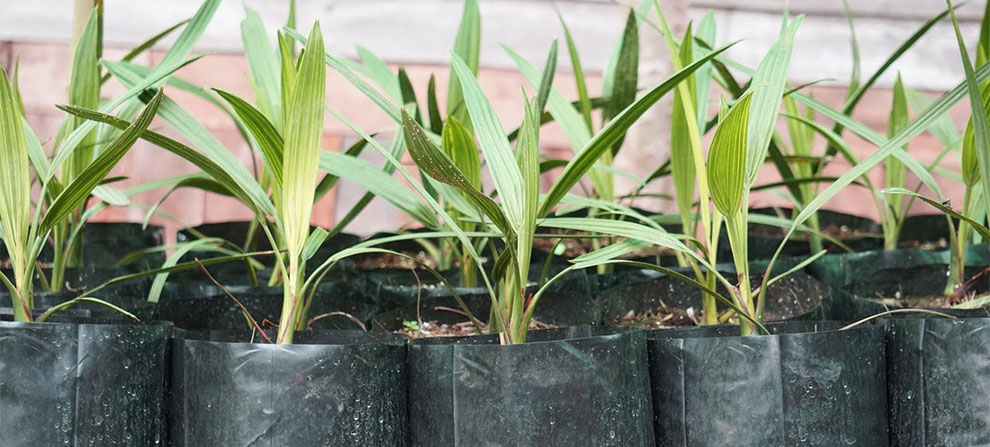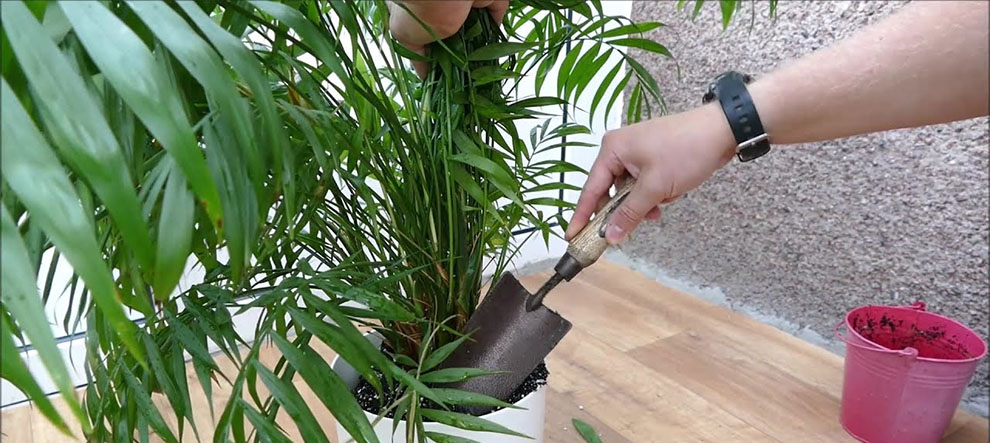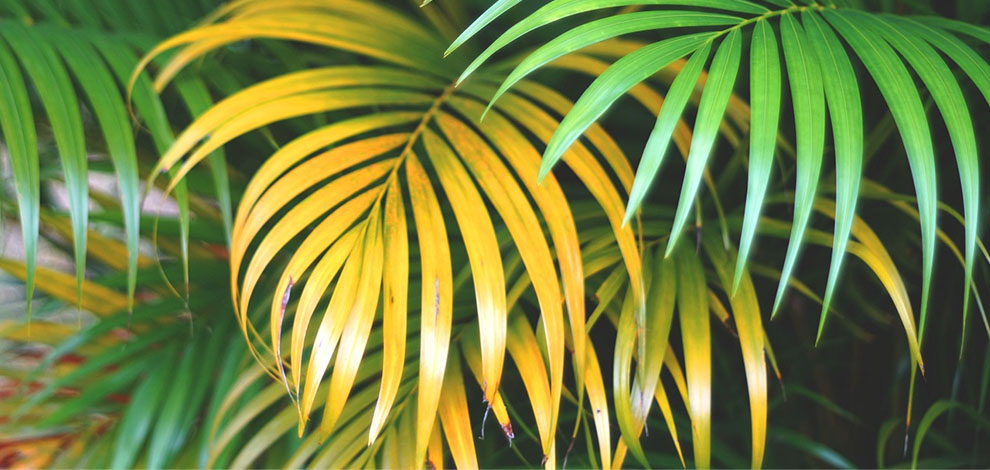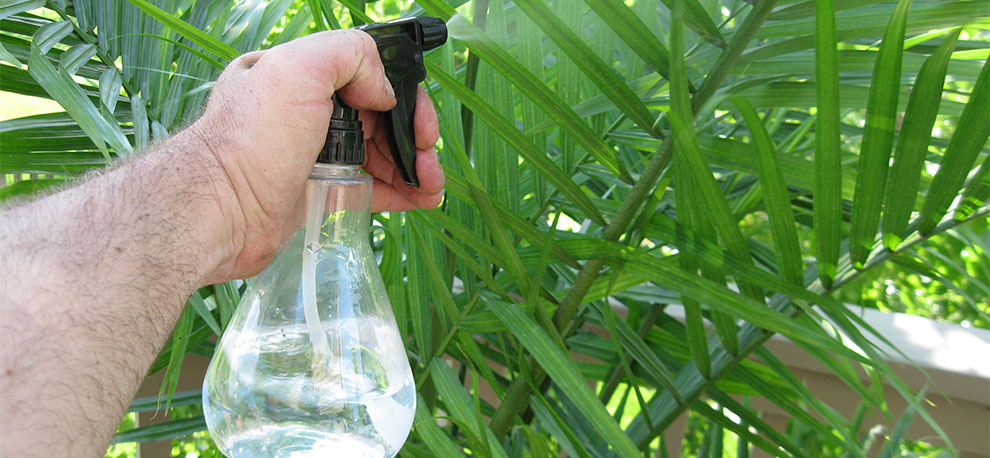Palm Plant Care & Growing Guide: Indoor + Outdoor Tips

Palm is famous for its green feather or fan-like fronds. But, how to care for a palm plant to keep its green leaves lush and healthy?
It may be astonishing for you to know, but palm trees are not trees. As a matter of fact, they are nothing but giant grasses. This is plausibly why they tend to grow taller once they are through with their initial growth phase but never advance sideways.
Palm can be a pretty fantastic choice for indoors, beautifying the area they are kept in. Belonging to the Arecaceae family (derived from areca, which means many palm species), these plants grow and thrive naturally in climates with high humidity and temperature levels.
We will try to address palm plant care tips through this guide below. So, let us get started and read some tips for indoor palm tree care. But, before we get started on how to take care of palm plants, we will first help you with the right planting guide to ensure you do not make any blunders.
In This Article:
- How Do You Grow Palms In Pots?
- How Do You Take Care Of A Palm Tree Indoors?
- What Is Wrong With My Palm Tree?
- Common Varieties Of Palm
- Do Outdoor Palm Need The Same Care As Indoors?
- FAQs
How To Grow Palm – Planting Guide

We will first look at the planting guide for the palms and then move on to the caring portion.
Right spot
Select a spot near the window where the plant could get indirect sunlight but make sure it does not receive too much direct sun or dry, hot air. You also need moist soil and slight humidity in the air for proper palm plant care. Consider the right place keeping in mind these points.
Right pot
You can opt for a ceramic, plastic, or terracotta pot for the proper indoor palm tree care. But, if you pick a terracotta pot, know that it tends to wick moisture from the soil. Depending on you and the plant species, it can prove to be both good and bad.
Growing from seed Vs. buying a plant
Some people may want to grow your palm from the seeds, while others wish to skip the hassle and directly buy the plant. Both things are quite doable, but the former will need more input from you.
Germination
For proper germination, palm trees will need a high temperature. So, the accepted range is somewhere between 70–100-degree Fahrenheit, but anywhere between 85-95 will yield an excellent outcome. Palm seeds germinate in full sun, but leaves of a few species tend to bleach a little. If you have understory palm seeds, they blossom well in the shade.
Repotting
See, if you wish to learn how to care for a palm plant, you cannot skip on drainage concerns and the need for repotting. A potted palm is supposed to rest on 1-3 inches of pebbles or stones at its base.stones at its base.
Also, please remember that for correct palm plant care, the pot must necessarily have a hole at the base. However, you must be gentle when performing the repotting as palms are pretty sensitive to repotting.
Also, repotting can be avoided as long as it is not necessary. Typically, repotting is required once every two or three years. If the plant is giant, always opt for a pot to take its weight.
Moisture requirements
For any plant to grow well, moisture is essential. However, the degree of humidity needed may vary from one plant to another. Some palms enjoy moisture only once a week; some dessert palms need even less water.
In contrast, a few variants also like moisture five times a week. When you decide to plant various palms in your backyard, try to bundle them as per their watering requirements, or else you may jeopardize the plant’s health. Hence, ensure that you pick the correct palm variant and give it adequate moisture for proper palm plant care.
Soil Mix
The soil underneath plays an essential role in indoor palm tree care. Thus, it is quintessential to achieve the right soil mix. Certain palm varieties grow well in alkaline soil, while others thrive on acidic ground.
You can use the regular potting soil for the plant, but do not forget to include perlite and peat in the mix.
Light
Light is typically one of the critical requirements for any indoor palm plant. Unfortunately, not all the homes receive good sunlight year-round, and not many are well lit either. But, fortunately for you, palms understand this and adapt to whatever light is available for them.
So, even if you offer a dim light to the plant, it does not intrude on the growth. Regardless, never expose the palm to direct sunlight as that can negatively affect the plant. This is one of the most essential palm plant care tips.
Temperature
Ensure that the plant receives the right temperature and humidity. Palms enjoy average temperature and humidity between 65-75 degrees. If the plant does not receive adequate humidity, its tips might turn brown. However, if there is inadequate humidity, you can install a cool-mist humidifier or regularly mist the plant.
Nutrition
When you aspire to learn how to care for a palm plant, understanding the nutrition requirements of the plant is also essential. You must feed the plant mainly during the active growing season from March to October.
The good thing is that plants tend to grow slowly. Hence, they do not have a massive fertilizer requirement, but they may suffer some deficiencies if their nutritional needs are not met.
How To Take Care Of Palm Plants?

Now that you have read through the palms’ planting guide let us not move to the palm plant care requirements.
Sunlight
Light is an essential factor in indoor palm tree care. You will have to look for the spot in your yard which receives the necessary light. The degree of light needed will vary from one species to another.
Also, if the plant does not receive the required sunlight (it gets more or less than necessary), it may die.
Soil
Are you wondering how to care for palm trees? Well, you ought to be careful with the soil. You can use the regular potting soil for the plant, but do not forget to include perlite and peat in the mix.
You can shop for a palm soil mixture or a cactus mix for growing palm trees. Fortunately, the palms can grow just well in commercial potting soil. Just add vermiculite or peat moss to it to make it more moisture retaining.
Fertilizer
For good palm plant care, you can either invest in a specialized palm fertilizer. Use a water-soluble fertilizer to offer the plant the proper nutrients, such as potassium, iron, and magnesium. To ensure your palm is well-fed, you should use the fertilizer a couple of times a year.
Water
Like most indoor plants, striking a balance with watering is quite essential. It is necessary to ensure that the soil is evenly moist, and for this, you must offer the plant good drainage in the pot. As a habit, you can consider watering the plant anytime you feel that the soil appears dry on top.
Pruning
Another important factor in indoor palm tree care is occasionally pruning to remove the dead and brown leaves. This is necessary to ensure that your plant thrives well. However, do not over prune the palm as the fronds are the plant’s key nutrition source.
Fighting the pests
Several bugs may attack your palm, such as spider mites. In addition, the mealybugs and insects can also infest the plant. So, of course, you need to combat them.
Now, instead of investing in a chemical pesticide, you must opt for a natural pesticide or any non-toxic solution, such as horticultural oils or organic oils. Insecticidal soaps are also a good pick. Regardless of the remedial action chosen, it is vital to act immediately for proper palm plant care.
More on weeds and pests: Do potato bug bites? How to get rid of goat heads weed?
Temperature
Even though some species are heartier, typically, all palms enjoy a balmy climate. Anywhere between 65°-75° degrees Fahrenheit is suitable, with nighttime temperatures not dropping below 55° degrees. Of course, the range may be different for different species, but palms do not typically enjoy a cool temperature or air.
How To Care For A Palm Plants Most Common Problems?

Despite the knowledge of indoor palm tree care, mistakes may sometimes happen. But, if there are problems, there are also solutions. Some prevalent issues that a palm may experience are:
Brown tips, spots, or the leaves
Watering is a crucial point in palm plant care as underwatering or dry air or cold air can result in brown tips or yellow leaves. Over watering may cause brown patches on the leaves or rotting.
Sometimes, the browning of leaves is a natural process in their lifecycle as well. You can cut them to allow new growth.
Related: How to save brown arborvitae from dying?|How to tell if a palm tree is dead?
Gray or scorched brown leaves
Exposure to too much sun or fertilizer can cause the leaves to appear brown or gray scorched. You can move the plant to a shadier spot or perform a soil cleanse.
Root rotting
The primary cause of root rotting is over-watering. If the root tends to rot, you need to check the soil and the container, as either two or both may be responsible for the same.
In addition, you need to ensure that they are draining fine. Please know this is a grave concern and must be tackled immediately.
Pests
Mealybugs, red spider mites, and scales may also be problematic for the palms.
However, for either of the above concerns, you can follow our listed palm plant care tips, alter the care and conditions, and the plant can recover just fine.
Toxicity
There are a few varieties of palms, which may be toxic for pets and humans. So, if you have furry friends, keep your palms out of their reach.
How Many Varieties Of Palms Are There?

With over 2500 varieties of palm, you will be spoiled for choice. Here are a few most prevalent ones.
- Chinese Fan Palm
- Pygmy Date Palm
- Pindo Palm
- Areca Palm
- Parlor Palm
- Triangle Palm
- Mediterranean Dwarf Palm
- Mazari Palm
- Majesty Palm
- Christmas Palm Tree
- Bottle Palm Tree
- Sago Palm
- Ponytail Palm
How To Care For Palm Trees Outdoor?

For palm plant care outdoors, you should know that outdoor palms grow in full sun but need protection from prolonged exposure to direct sun.
If you have a newly planted tree, you need to water it two times a week until they are about two to three months old. Now that your palms are established, they become drought tolerant and do not need much water.
Your palms love food. So, you can feed it with a slow-releasing top-quality fertilizer during early spring. If your soil lacks nutrients, you can provide it again during early fall.
Palm trunks may be wrapped with frost cloth or burlap in cooler regions or during harsh weather. This can prevent or at least lower damage. Adding a thick mulch layer and deep watering before severe weather can be an excellent way to shield your palm roots in freezing temperatures.
Related read: Mexican Fan Palm Growth Rate,How To Care for Date Palms,How To Care For Areca Palm,Date Palm Life Expectancy
Indoor Palm Tree Care – FAQs
Ques 1. Which palms can you grow indoors?
Ans. A fantastic choice of palm that you can grow indoors is the parlor palm. It is a slow-growing tree but incredibly low-maintenance. In contrast to the other palm trees, this one requires very little light.
So, it can be planted in any corner of the house but your closet. Beyond this, Chinese fan palms, lady palms, and ponytail palms are also excellent picks for houseplants.
Related: How fast do ponytail palm grow|How to tell if a palm tree is dead?
Ques 2. Can palms live indoors?
Ans. Yes, there are many varieties in palm trees, which can grow well indoors, provided, of course, you know the right palm plant care tips.
Ques 3. Do palm plants need direct sunlight?
Ans . Even though palms are pretty forgiving, you must avoid direct sun. Direct, full sunlight tends to burn the leaves and result in brown leaf tips or curling. Hence, keeping your plant in partial shade or indoors is advised where the plant gets indirect sunlight.
Ques 4. How often should palm plants be watered?
Ans . In the first week, the indoor palm must be watered every day, and in the second week, you can water the plant every other day. From the third week onwards, water it thrice a week. After the plant has been established, water it about two-three times a week.
Ques 5. Should I cut off Brown palm leaves?
Ans . Once the leaves turn brown, you can chop them off.
Ques 6. Do you soak palm seeds before planting?
Ans . Presoaking one to seven days in advance is recommended before the palm seed plantation.
Ques 7. Do palm seeds need light to germinate?
Ans . Palms can germinate in dark environments or without sunlight. But post-germination, they will require sunlight.
Ques 8. How do you propagate an indoor palm tree?
Ans . Given the manner of growing, palm trees cannot be propagated via asexual means. So, to start a palm tree, you will most definitely need a seed, or you can propagate them through the off-shoots from the plant.
Hope you had a good read with our indoor palm tree care guide. Read more on palm tree growth rate, palm types, and life expectancy here.
